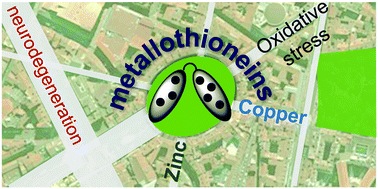当前位置:
X-MOL 学术
›
Chem. Soc. Rev.
›
论文详情
Our official English website, www.x-mol.net, welcomes your
feedback! (Note: you will need to create a separate account there.)
Chemistry of mammalian metallothioneins and their interaction with amyloidogenic peptides and proteins†‡
Chemical Society Reviews ( IF 40.4 ) Pub Date : 2017-11-08 00:00:00 , DOI: 10.1039/c7cs00448f Elena Atrián-Blasco 1 , Alice Santoro , Dean L Pountney , Gabriele Meloni , Christelle Hureau , Peter Faller
Chemical Society Reviews ( IF 40.4 ) Pub Date : 2017-11-08 00:00:00 , DOI: 10.1039/c7cs00448f Elena Atrián-Blasco 1 , Alice Santoro , Dean L Pountney , Gabriele Meloni , Christelle Hureau , Peter Faller
Affiliation

|
Cu and Zn ions are essential in most living beings. Their metabolism is critical for health and mis-metabolism can be lethal. In the last two decades, a large body of evidence has reported the role of copper, zinc and iron, and oxidative stress in several neurodegenerative diseases like Alzheimer's, Parkinson's, prion diseases, etc. To what extent this mis-metabolism is causative or a consequence of these diseases is still a matter of research. In this context metallothioneins (MTs) appear to play a central gate-keeper role in controlling aberrant metal–protein interactions. MTs are small proteins that can bind high amounts of Zn(II) and Cu(I) ions in metal-cluster arrangements via their cysteine thiolates. Moreover, MTs are well known antioxidants. The present tutorial outlines the chemistry underlying the interconnection between copper(I/II) and zinc(II) coordination to amyloidogenic proteins and MTs, and their redox properties in generation and/or silencing reactive oxygen species (overproduced in oxidative stress) and other reactants. These studies have revealed the coordination chemistry involved in neurodegenerative diseases and the interactions between MTs and amyloidogenic protein metal-complexes (like amyloid-β, α-synuclein and prion-protein). Overall, the protective role of MTs in neurodegenerative processes is emerging, serving as a foundation for exploring MT chemistry as inspiration for therapeutic approaches.
中文翻译:

哺乳动物金属硫蛋白的化学性质及其与淀粉样肽和蛋白质的相互作用†‡
铜离子和锌离子对于大多数生物都是必需的。它们的新陈代谢对健康至关重要,代谢错误可能致命。在过去的二十年中,大量证据报道了铜、锌和铁以及氧化应激在几种神经退行性疾病(如阿尔茨海默病、帕金森病、朊病毒病等)中的作用。这种代谢错误在多大程度上是致病因素或影响因素?这些疾病的后果仍然是一个研究问题。在这种情况下,金属硫蛋白(MT)似乎在控制异常金属-蛋白质相互作用中发挥着中心看门人的作用。 MT 是一种小蛋白质,可以通过其半胱氨酸硫醇盐结合金属簇排列中的大量 Zn( II ) 和 Cu() 离子。此外,MT 是众所周知的抗氧化剂。本教程概述了铜 ( II ) 和锌 ( II ) 与淀粉样蛋白和 MT 配位之间相互联系的化学原理,以及它们在产生和/或沉默活性氧(在氧化应激中过量产生)和其他反应物中的氧化还原特性。这些研究揭示了神经退行性疾病中涉及的配位化学以及 MT 与淀粉样蛋白金属复合物(如淀粉样蛋白-β、α-突触核蛋白和朊病毒蛋白)之间的相互作用。总体而言,MT 在神经退行性过程中的保护作用正在显现,为探索 MT 化学作为治疗方法的灵感奠定了基础。
更新日期:2017-11-08
中文翻译:

哺乳动物金属硫蛋白的化学性质及其与淀粉样肽和蛋白质的相互作用†‡
铜离子和锌离子对于大多数生物都是必需的。它们的新陈代谢对健康至关重要,代谢错误可能致命。在过去的二十年中,大量证据报道了铜、锌和铁以及氧化应激在几种神经退行性疾病(如阿尔茨海默病、帕金森病、朊病毒病等)中的作用。这种代谢错误在多大程度上是致病因素或影响因素?这些疾病的后果仍然是一个研究问题。在这种情况下,金属硫蛋白(MT)似乎在控制异常金属-蛋白质相互作用中发挥着中心看门人的作用。 MT 是一种小蛋白质,可以通过其半胱氨酸硫醇盐结合金属簇排列中的大量 Zn( II ) 和 Cu() 离子。此外,MT 是众所周知的抗氧化剂。本教程概述了铜 ( II ) 和锌 ( II ) 与淀粉样蛋白和 MT 配位之间相互联系的化学原理,以及它们在产生和/或沉默活性氧(在氧化应激中过量产生)和其他反应物中的氧化还原特性。这些研究揭示了神经退行性疾病中涉及的配位化学以及 MT 与淀粉样蛋白金属复合物(如淀粉样蛋白-β、α-突触核蛋白和朊病毒蛋白)之间的相互作用。总体而言,MT 在神经退行性过程中的保护作用正在显现,为探索 MT 化学作为治疗方法的灵感奠定了基础。











































 京公网安备 11010802027423号
京公网安备 11010802027423号